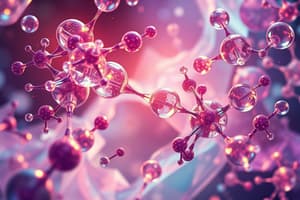Podcast
Questions and Answers
What is the smallest unit of matter that can't be divided by chemical means?
What is the smallest unit of matter that can't be divided by chemical means?
atom
Which scientist produced one of the first periodic tables in the 1860s?
Which scientist produced one of the first periodic tables in the 1860s?
- J.J. Thomson
- Dmitri Mendeleev (correct)
- John Dalton
- Marie Curie
What do elements in the same group of the periodic table have in common?
What do elements in the same group of the periodic table have in common?
- They have the same mass.
- They have identical atomic numbers.
- They have the same number of valence electrons. (correct)
- They have the same number of electron shells.
What are the properties of Alkali Metals?
What are the properties of Alkali Metals?
Match the following groups in the periodic table with their properties:
Match the following groups in the periodic table with their properties:
How many groups are there in the periodic table?
How many groups are there in the periodic table?
What type of ions do elements from Group 16 form?
What type of ions do elements from Group 16 form?
Flashcards are hidden until you start studying
Study Notes
Instructor Profile
- Clarisse Jessica A. Mayores, RMT, is the instructor for the Introduction to Organic Chemistry course at Marinduque State University.
- Education: Bachelor of Science in Medical Technology, University of Santo Tomas, set to graduate in August 2024 as Magna Cum Laude.
- Contact: Phone - 0960-585-6131, Email - [email protected].
Basics of Matter
- Matter consists of atoms, which are the smallest units that retain unique properties and cannot be divided by chemical means.
Periodic Table of Elements
- Developed in the 1860s by Dmitri Mendeleev, the periodic table categorizes 118 known elements based on their properties.
- Divided into Periods (horizontal rows) and Groups (vertical columns).
- There are 7 periods, each indicating the number of electron shells in the corresponding elements.
- 18 groups where elements share similar chemical properties due to the same number of valence electrons.
Groups in the Periodic Table
Group 1: Alkali Metals
- Elements: Lithium (Li), Sodium (Na), Potassium (K), Rubidium (Rb), Cesium (Cs), Francium (Fr).
- Properties: Highly reactive, soft, low density, forms +1 cations.
Group 2: Alkaline Earth Metals
- Elements: Beryllium (Be), Magnesium (Mg), Calcium (Ca), Strontium (Sr), Barium (Ba), Radium (Ra).
- Properties: Reactive (less than alkali metals), harder, denser, forms +2 cations.
Groups 3-12: Transition Metals
- Elements: Includes Scandium (Sc), Titanium (Ti), Iron (Fe), Copper (Cu), Zinc (Zn), among others.
- Properties: Various oxidation states, colored compounds, high conductivity, melting points, and densities.
Group 13: Boron Group
- Elements: Boron (B), Aluminum (Al), Gallium (Ga), Indium (In), Thallium (Tl).
- Properties: Range from metalloids (Boron) to metals (the rest), forms +3 cations.
Group 14: Carbon Group
- Elements: Carbon (C), Silicon (Si), Germanium (Ge), Tin (Sn), Lead (Pb).
- Properties: Variation from nonmetals (Carbon) to metals (Lead), forms +4 or +2 cations.
Group 15: Nitrogen Group
- Elements: Nitrogen (N), Phosphorus (P), Arsenic (As), Antimony (Sb), Bismuth (Bi).
- Properties: Mix of nonmetals (N, P), metalloids (As, Sb), metals (Bi); forms -3, +3, +5 oxidation states.
Group 16: Oxygen Group
- Elements: Oxygen (O), Sulfur (S), Selenium (Se), Tellurium (Te), Polonium (Po).
- Properties: Includes nonmetals (O, S), metalloids (Se, Te), metals (Po); typically forms -2 anions.
Group 17: Halogens
- Elements: Fluorine (F), Chlorine (Cl), Bromine (Br), Iodine (I), Astatine (At).
- Properties: Very reactive nonmetals, form -1 anions, strong oxidizers.
Group 18: Noble Gases
- Elements: Helium (He), Neon (Ne), Argon (Ar), Krypton (Kr)...
- Properties: Generally inert, stable electron configuration.
Studying That Suits You
Use AI to generate personalized quizzes and flashcards to suit your learning preferences.




